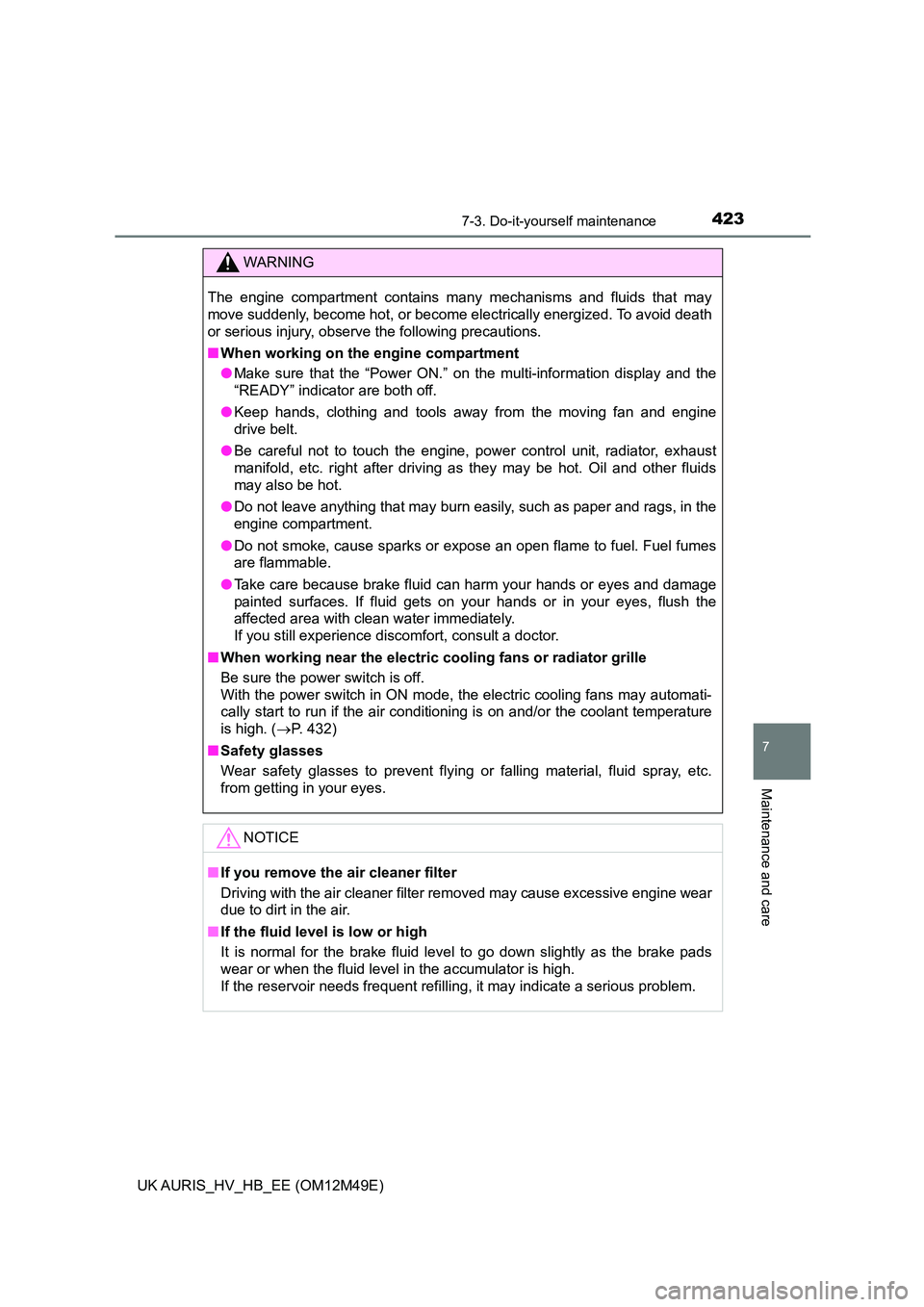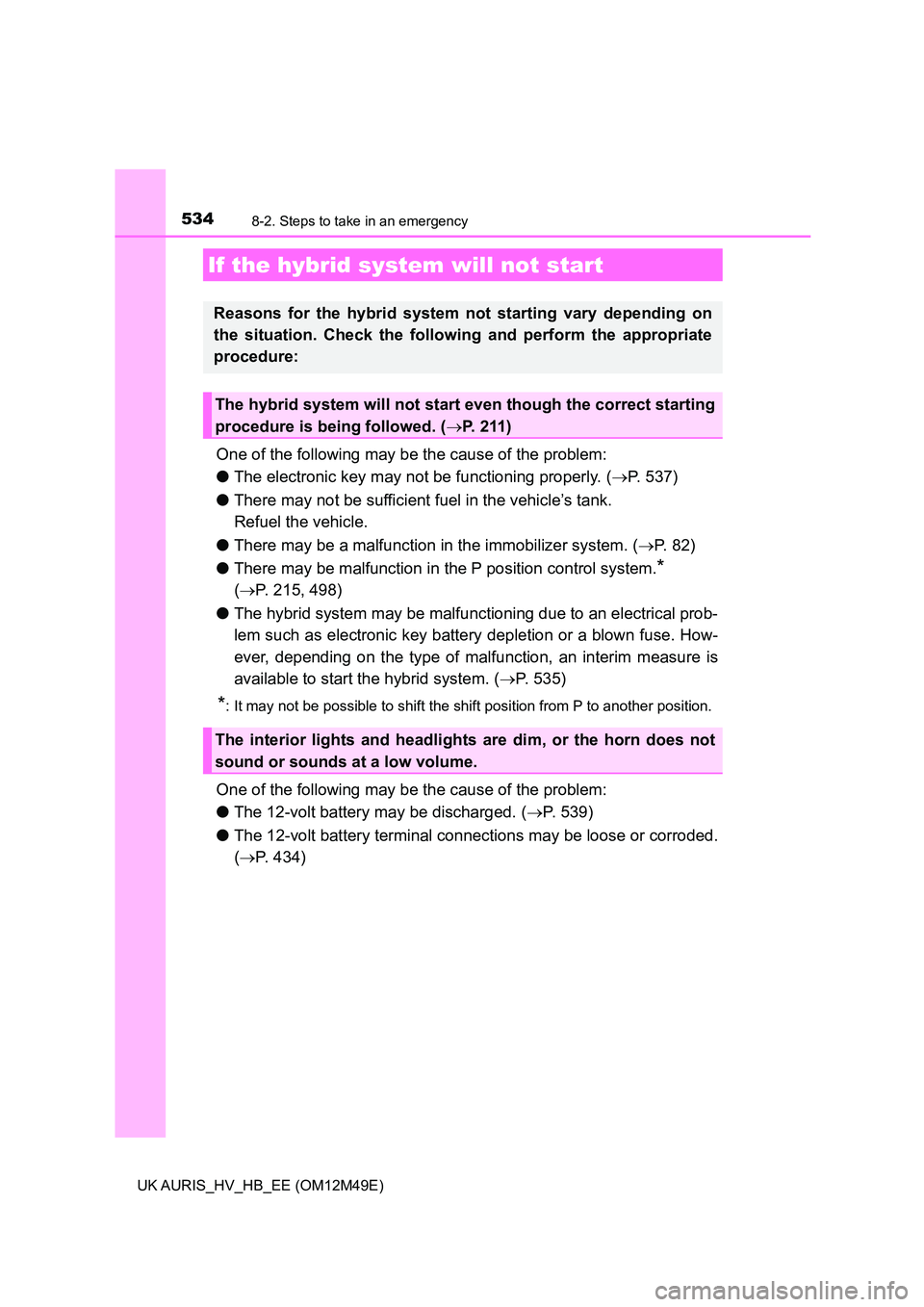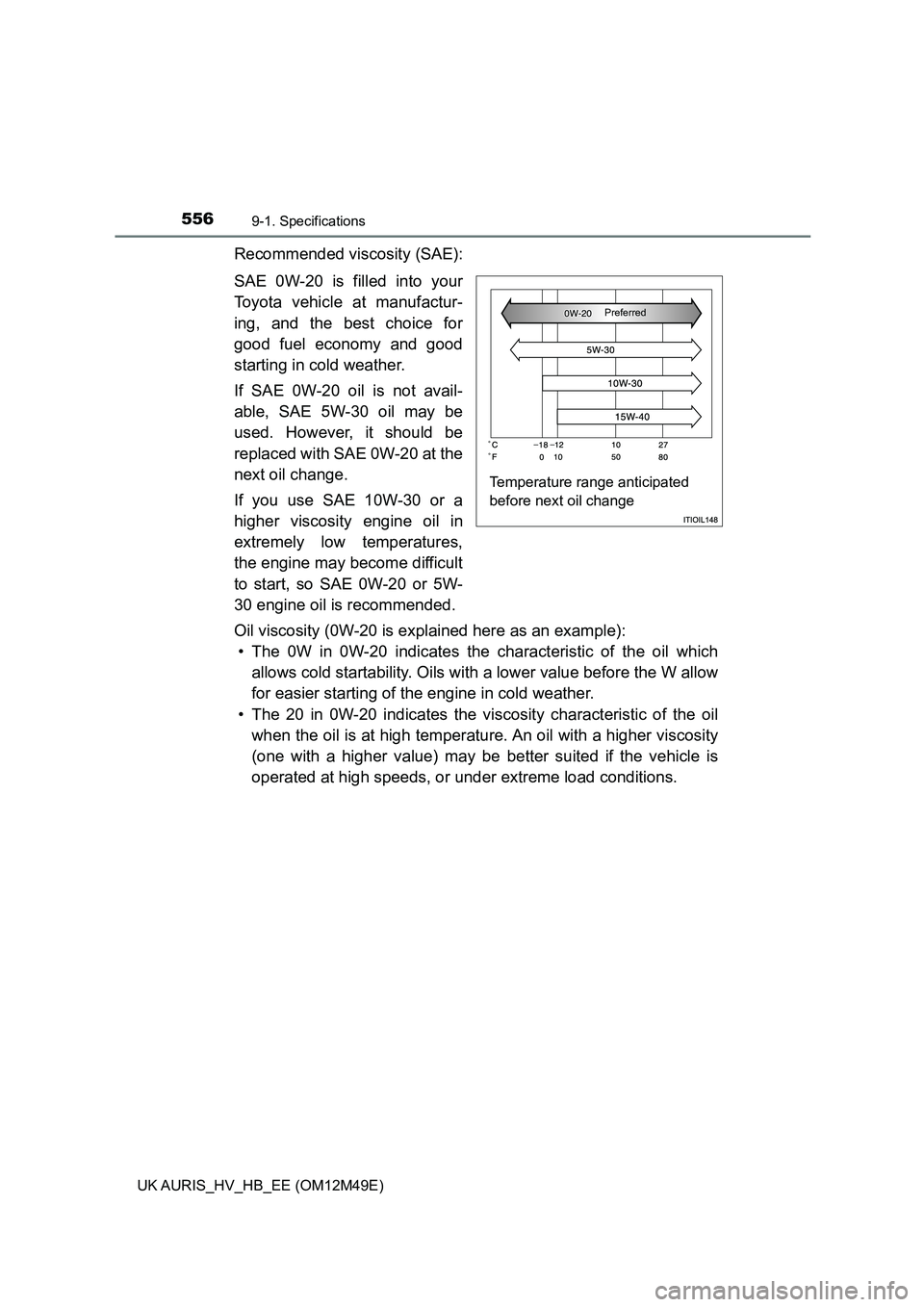Page 423 of 592

4237-3. Do-it-yourself maintenance
UK AURIS_HV_HB_EE (OM12M49E)
7
Maintenance and care
WARNING
The engine compartment contains many mechanisms and fluids that may
move suddenly, become hot, or become electrically energized. To avoid death
or serious injury, observe the following precautions.
■ When working on the engine compartment
● Make sure that the “Power ON.” on the multi-information display and the
“READY” indicator are both off.
● Keep hands, clothing and tools away from the moving fan and engine
drive belt.
● Be careful not to touch the engine, power control unit, radiator, exhaust
manifold, etc. right after driving as they may be hot. Oil and other fluids
may also be hot.
● Do not leave anything that may burn easily, such as paper and rags, in the
engine compartment.
● Do not smoke, cause sparks or expose an open flame to fuel. Fuel fumes
are flammable.
● Take care because brake fluid can harm your hands or eyes and damage
painted surfaces. If fluid gets on your hands or in your eyes, flush the
affected area with clean water immediately.
If you still experience discomfort, consult a doctor.
■ When working near the electric cooling fans or radiator grille
Be sure the power switch is off.
With the power switch in ON mode, the electric cooling fans may automati-
cally start to run if the air conditioning is on and/or the coolant temperature
is high. ( P. 432)
■ Safety glasses
Wear safety glasses to prevent flying or falling material, fluid spray, etc.
from getting in your eyes.
NOTICE
■ If you remove the air cleaner filter
Driving with the air cleaner filter removed may cause excessive engine wear
due to dirt in the air.
■ If the fluid level is low or high
It is normal for the brake fluid level to go down slightly as the brake pads
wear or when the fluid level in the accumulator is high.
If the reservoir needs frequent refilling, it may indicate a serious problem.
Page 453 of 592
4537-3. Do-it-yourself maintenance
UK AURIS_HV_HB_EE (OM12M49E)
7
Maintenance and care
Tire inflation pressure is specified on the label on the driver's side
door frame as shown.
■ Effects of incorrect tire inflation pressure
Driving with incorrect tire inflation pressure may result in the following:
● Reduced fuel economy
● Reduced driving comfort and poor handling
● Reduced tire life due to wear
● Reduced safety
● Damage to the drivetrain
If a tire needs frequent inflating, have it checked by any authorized Toyota
dealer or repairer, or another duly qualified and equipped professional.
Tire inflation pressure
Make sure to maintain proper tire inflation pressure. Tire infla-
tion pressure should be checked at least once per month. How-
ever, Toyota recommends that tire inflation pressure be checked
once every two weeks. ( P. 560)
Tire-loading information label
Left-hand drive vehiclesRight-hand drive vehicles
Page 493 of 592

4938-2. Steps to take in an emergency
UK AURIS_HV_HB_EE (OM12M49E)
8
When trouble arises
(If equipped)
PCS warning light
When the warning light flashes (and a buzzer sounds):
Indicates a malfunction in the PCS (Pre-Crash Safety sys-
tem)
Have the vehicle inspected by any authorized Toyota
dealer or repairer, or another duly qualified and
equipped professional immediately.
When the warning light illuminates:
Indicates that the PCS (Pre-Crash Safety system) is tem-
porarily unavailable, possibly due to either of the following:
• The part of the windshield around the front sensor being
dirty, fogged up or covered with condensation, ice, stick-
ers, etc.
Clear the dirt, fog, condensation, ice, stickers, etc.
( P. 250)
• Front sensor temperature being outside of its opera-
tional range
Wait for a while until the area around the front sensor
has cooled down sufficiently.
• Either the VSC (Vehicle Stability Control) system or PCS
(Pre-Crash Safety system) is disabled or both are dis-
abled.
To enable the PCS, enable both the VSC system and
PCS. ( P. 255, 307)
Low fuel level warning light
Indicates that remaining fuel is approximately 6.8 L (1.8
gal., 1.5 Imp. gal.) or less
Refuel the vehicle.
Driver’s and front passenger’s seat belt reminder light
(warning buzzer)*2
Warns the driver and/or front passenger to fasten their
seat belts
Fasten the seat belt.
If the front passenger’s seat is occupied, the front
passenger’s seat belt also n eeds to be fastened to
make the warning light (warning buzzer) turn off.
Warning lightWarning light/Details/Actions
Page 495 of 592

4958-2. Steps to take in an emergency
UK AURIS_HV_HB_EE (OM12M49E)
8
When trouble arises
■Front passenger detection sensor, seat belt reminder and warning
buzzer
● If luggage is placed on the front passenger seat, the front passenger detec-
tion sensor may cause the warning light to flash and the warning buzzer to
sound even if a passenger is not sitting in the seat.
● If a cushion is placed on the seat, the sensor may not detect a passenger,
and the warning light may not operate properly.
■ If the malfunction indicator lamp comes on while driving
The malfunction indicator lamp will come on if the fuel tank becomes com-
pletely empty. If the fuel tank is empty, refuel the vehicle immediately. The
malfunction indicator lamp will go off after several trips.
If the malfunction indicator lamp does not go off, contact any authorized
Toyota dealer or repairer, or another duly qualified and equipped professional
as soon as possible.
■ When the tire pressure warning light comes on (vehicles with a tire pres-
sure warning system)
Carry out the following procedure after the tire temperature has lowered suffi-
ciently.
● Check the tire inflation pressure and adjust it to the appropriate level.
● If the warning light does not go out after several minutes, check that the tire
inflation pressure is at the specified level and carry out initialization.
The warning light may come on again if the above operations are conducted
without first allowing the tire temperature to lower sufficiently.
■ The tire pressure warning light may come on due to natural causes
(vehicles with a tire pressure warning system)
The tire pressure warning light may come on due to natural causes such as
natural air leaks and tire inflation pressure changes caused by temperature.
In this case, adjusting the tire inflation pressure will turn off the warning light
(after a few minutes).
■ When a tire is replaced with a spare tire (vehicles with a tire pressure
warning system)
The compact spare tire is not equipped with a tire pressure warning valve and
transmitter. If a tire goes flat, the tire pressure warning light will not turn off
even though the flat tire has been replaced with the spare tire. Replace the
spare tire with the repaired tire and adjust the tire inflation pressure. The tire
pressure warning light will go off after a few minutes.
■ Conditions that the tire pressure warning system may not function prop-
erly (vehicles with a tire pressure warning system)
P. 443
Page 534 of 592

5348-2. Steps to take in an emergency
UK AURIS_HV_HB_EE (OM12M49E)
One of the following may be the cause of the problem:
● The electronic key may not be functioning properly. (P. 537)
● There may not be sufficient fuel in the vehicle’s tank.
Refuel the vehicle.
● There may be a malfunction in the immobilizer system. (P. 8 2 )
● There may be malfunction in the P position control system.*
( P. 215, 498)
● The hybrid system may be malfunctioning due to an electrical prob-
lem such as electronic key battery depletion or a blown fuse. How-
ever, depending on the type of malfunction, an interim measure is
available to start the hybrid system. ( P. 535)
*: It may not be possible to shift the shift position from P to another position.
One of the following may be the cause of the problem:
● The 12-volt battery may be discharged. (P. 539)
● The 12-volt battery terminal connections may be loose or corroded.
( P. 434)
If the hybrid system will not start
Reasons for the hybrid system not starting vary depending on
the situation. Check the follo wing and perform the appropriate
procedure:
The hybrid system will not st art even though the correct starting
procedure is being followed. ( P. 211)
The interior lights and headlights are dim, or the horn does not
sound or sounds at a low volume.
Page 551 of 592
551
9Vehicle specifications
UK AURIS_HV_HB_EE (OM12M49E)
9-1. Specifications
Maintenance data
(fuel, oil level, etc.)........... 552
Fuel information ................. 564
9-2. Customization
Customizable features ....... 566
9-3. Initialization
Items to initialize ................ 573
Page 554 of 592
5549-1. Specifications
UK AURIS_HV_HB_EE (OM12M49E)
Engine
Model2ZR-FXE
Ty p e4-cylinder in line, 4-cycle, gasoline
Bore and stroke80.5 88.3 mm (3.17 3.48 in.)
Displacement1798 cm3 (109.7 cu. in.)
Valve clearance
(engine cold)Automatic adjustment
Fuel
Fuel type
When you find these types of fuel label at the
gas station, use only the fuel with one of the fol-
lowing labels.
EU area:
Unleaded gasoline conforming to European
standard EN228 only
Except EU area:
Unleaded gasoline only
Research Octane
Number95 or higher
Fuel tank capacity
(Reference)45 L (11.9 gal., 9.9 Imp. gal.)
Electric motor (traction motor)
Ty p ePermanent magnet motor
Maximum output60 kW
Maximum torque207 N•m (21.1 kgf•m, 153 ft•lbf)
Page 556 of 592

5569-1. Specifications
UK AURIS_HV_HB_EE (OM12M49E)
Recommended viscosity (SAE):
SAE 0W-20 is filled into your
Toyota vehicle at manufactur-
ing, and the best choice for
good fuel economy and good
starting in cold weather.
If SAE 0W-20 oil is not avail-
able, SAE 5W-30 oil may be
used. However, it should be
replaced with SAE 0W-20 at the
next oil change.
If you use SAE 10W-30 or a
higher viscosity engine oil in
extremely low temperatures,
the engine may become difficult
to start, so SAE 0W-20 or 5W-
30 engine oil is recommended.
Oil viscosity (0W-20 is explained here as an example):
• The 0W in 0W-20 indicates the characteristic of the oil which
allows cold startability. Oils with a lower value before the W allow
for easier starting of the engine in cold weather.
• The 20 in 0W-20 indicates the viscosity characteristic of the oil
when the oil is at high temperature. An oil with a higher viscosity
(one with a higher value) may be better suited if the vehicle is
operated at high speeds, or under extreme load conditions.
Temperature range anticipated
before next oil change
Preferred